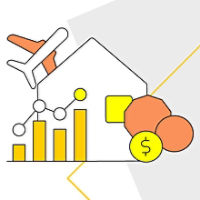“Lower petrol prices and government energy relief programs have eased the pressure on essential spending and July’s income tax cuts have increased take home pay for many Australians, however there continues to be a discrepancy between the spending power of older and younger Australians. In fact, we’ve seen those all the way up to 40 years-old cut back on spending, highlighting the large swathe of the population feeling cost of living pressure,” said Wade Tubman, CommBank iQ Head of Innovation and Analytics.
Essential spending slows
Spending on the essentials has halved in the past year, down to 1.7 per cent, as the share of wallet between essential and discretionary spending is now nearly equal ($1,383 per capita per month vs $1,379). The slowdown was driven by decreases in petrol prices (down 6 per cent) and reduced utilities spending (down 3 per cent). Conversely, spending on Insurance (+10 per cent), Medical and Pharmacies, (+7 per cent), and Education (+6 per cent) continued to rise.
Spending rises in categories of value and convenience
A 5 per cent increase in spending on the ‘General Retail’ category over the past year was driven by convenience and cheaper alternatives, driven by increased spending on online marketplaces (+20 per cent). Spending on food delivery (+6 per cent), streaming services (+13 per cent), and discount stores (+6 per cent) also rose.
“Cost-conscious Australians continue to make trade-offs in the current environment. The fact that spending has increased on food delivery and streaming services suggests consumers are foregoing meals out to treat themselves at home. Consumers are also opting for discount purchases online, reflecting an environment of belt-tightening,” said Mr Tubman.
Regions remain resilient, as WA and Qld top spending
The divide between metro and regional areas persists, though it has not worsened. Regional Australia continues to outpace its metro counterparts, with spending growth at 2.2 per cent compared to 1.3 per cent in metro areas.
Despite both facing inflationary pressures, regional communities are showing signs of resilience likely due to different cost structures and lifestyles, such as heightened property prices and rents in metro areas.
On a state-by-state basis, Western Australia experienced the highest growth in spending at 3.0 per cent, driven by leisure and travel spending, followed by Queensland with 2.1 per cent growth. In contrast, Victoria reported the lowest spending growth at 0.4 per cent as households continue to exercise spending restraint.
“Western Australia’s strong spending growth, particularly in regional areas, highlights the ongoing confidence of the state’s consumers,” said Mr Tubman.
“Queensland’s discretionary spending growth indicates a more optimistic outlook among consumers, who were also likely buoyed by the state government’s energy concessions and discounted public transport initiatives. Spending by Victorians on the other hand reflects a cautious consumer prioritising must-have essentials over discretionary items,” commented Mr Tubman.
About CommBank iQ
CommBank iQ is a joint venture between Commonwealth Bank of Australia and data science and artificial intelligence company Quantium, which uses de-identified payments data from approximately 7 million CBA customers –– to track spending trends.
CommBank iQ's cost-of living analysis evaluates a range of metrics that indicate changes in cost of living and the different ways Australians are responding. Most economic data is based on national averages – yet businesses serve real people who face unique pressures and make individual choices. Understanding the variation in circumstances can help inform strategic business decision-making. To make stronger customer-led decisions in support of business goals, contact the CommBank iQ team at: CommBankiQ.info@cba.com.au.
Many Australian households are finding it harder to deal with current cost of living pressures. CommBank is supporting those who need our help with a range of initiatives. CommBank’s Cost of Living Support Hub provides a range of tools, tips and guidance to help our customers navigate current cost of living pressures.



